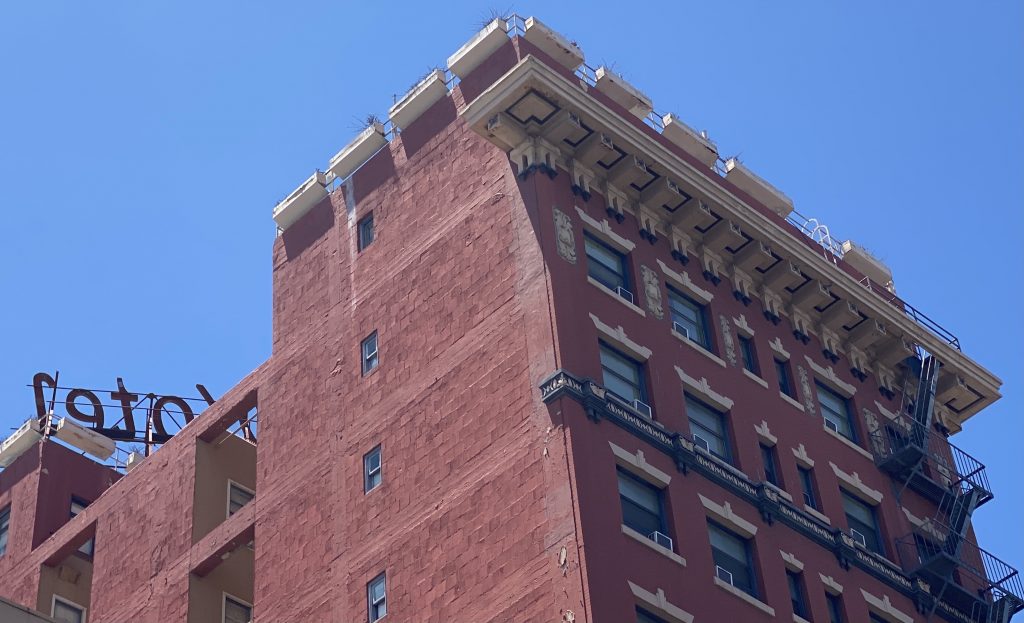Landmarks
If One Is Good, Two Is Better!
In the late 1880s, the glittering St. James Hotel was the city’s first skyscraper; it was an amazing five stories high! It was called the “glittering St. James” because the upper three stories were adorned with round tin plates ,which shone brilliantly when hit by the sun. The building, built by Dr. Peter Remondino, literally drew people to it. Under its mansard roof, fortunes were made, big business deals were planned and executed and a few swindles were plotted and set into motion. The sale and buying of real estate dominated early San Diego’s boom years, and the elegant hotel with its fine food and accommodations provided the ideal venue for such wheeling and dealing. It quickly replaced the aging Horton House as San Diego’s finest hotel.
The builder of this memorable edifice was Dr. Peter C. Remondino, one of San Diego’s first and most prominent surgeons, a Civil War (Union) veteran, prolific published author, president of the San Diego Medical Society, member of the State Board of Health, scholar and entrepreneur. It was he who realized that the Horton House had run its course, and like most men of the era in San Diego, he was engaged in buying real estate. The good doctor reasoned that San Diego needed a truly impressive hotel, and his mission was to provide one.
The opulent new hotel did not disappoint. The two lower stories were faced with brick, and the three wood covered upper stories were covered with round tin plates. All of this splendor was topped with a mansard roof, and adorned with plentiful and elaborate Victorian trimming (“gingerbread”). As the building towered over everything in the city, the view from the top was breath-taking. The 150 rooms were filled constantly, and it was considered an honor to be seated at the “first” dining table.The St. James had a huge barroom, and as the hotel’s facilities became so over taxed, Dr. Remondino had to add an annex on 7th and F Streets.
The hotel was managed by Captain A. J. Gordon, a feisty little Englishman, who dressed with much flare and rode along the dirt streets of the downtown area on his spirited stallion. Prosperity was everywhere and business was booming.
However, in 1893 a worldwide depression struck, and suddenly everyone was trying to sell their land. The boom days were over. Captain Gordon was replaced by a new manager and then another one. Dr. Remondino eventually took over as manager, but the glorious days of the glittering hotel were over. The St. James became a rooming house, and the annex became a post office. Across the bay, the Hotel del Coronado was attracting visitors, and the St. James, having seen its best days, was demolished.

The St. James Hotel
1885
Corner of 6th and E St.
Architect: Unknown
Architectural Style: Commercial Victorian
But – lo and behold – like a Phoenix rising from the ashes – emerged the new St. James Hotel on the very same street! Rapid construction was of prime importance, as the hotel was planned to capitalize on the upcoming Panama – California Exposition in Balboa Park. The owners, Morris E. Meyer and Isaac T. Davidson, contracted Henry Harms Preibisuis to design and build this new 11-story building. Preibisuis hired 13 workers to labor 55 hours a week, and paid them in gold. It took the workers a little over a year to finish the structure. When completed, it was the tallest building in the city, and advertised as “absolutely fireproof and first-class in every respect.” It was steel reinforced concrete throughout.
The edifice was designed in a commercial style with a flat roof, decorative lentils, a concrete foundation and a metal fire escape extending the entire height of the building. The facade of the first two floors was highly ornamented, while the remaining floors were relatively plain with little ornamentation. The ground floor featured large, plate glass windows and retail areas and a recessed entrance covered by a large canvas awning.
The second through the eleventh floors contained six wood framed, double hung sash style windows, with two set in pairs on either side of two small single windows. A pressure tank in the basement delivered hot and cold water to every floor, and two high-speed electric elevators and a freight elevator carried guests and supplies to the 146 rooms.
On the ground floor was a spacious lobby with tiled floors, scagliola (embossed plaster) columns and a paneled ceiling. The furniture was mahogany. In the rear of the lobby was a mezzanine floor, providing quarters for ladies. Beneath this were hotel offices, a checkroom, and a writing room for gentlemen. The basement housed a barber shop, a Turkish bath, and a billiard room. To further tempt prospective guests, the eleventh floor provided two sample rooms for public exhibition and an observatory. Seventy five of the rooms had private baths, while the public baths included showers. And – the view from the observatory was amazing. All in all, it was a formidable building , built to withstand the test of time.
The St. James Hotel, now owned by Ramada, still operates as a hotel. Though the rooms have been updated to reflect modern amenities, many of the original decorative features remain the same. The bar in the lobby is of special interest to guests, as it was purportedly owned by actress, Joan Crawford. It still has marks left by her stiletto heels as she danced on the bar top.

The New St. James Hotel
1912
844 6th Avenue
Architect: Henry Harms Preibisius
Commercial – Chicago School of Architecture Elements
The St. James is still a fine hotel, and its iconic rooftop sign identifies it as a downtown landmark.
Sandee is the historian for the Gaslamp Quarter Historical Foundation. She can be reached at [email protected].

